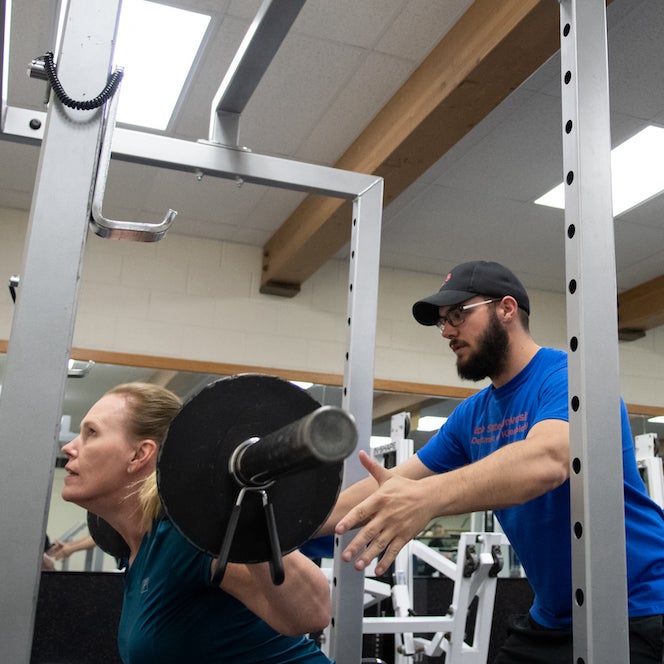Fitness
Fitness and exercise routines for Ramadan 2024: Try these workouts to stay active while fasting

As the holy month of Ramadan approaches, devout Muslims around the world prepare to observe daily fasts from sunrise to sunset. Ramadan, the ninth month of the Islamic calendar, is all about fasting, spiritual growth, prayers and reflection. It’s a time for Muslims to deepen their bond with their community, draw closer to God, seek forgiveness, and cultivate empathy for those in need. By abstaining from food and drink from dawn to dusk, self-discipline is cultivated and a stronger connection with God is felt. (Also read | Mindful fasting: Tips to maintain mental and emotional well-being throughout Ramadan fasting)
During Ramadan, mindfulness is encouraged to deepen spiritual connection, but integrating exercise into daily routines can enhance this practice. Exercise not only fosters mindfulness but also boosts energy levels, enabling individuals to remain attentive to their spiritual and physical well-being. Additionally, regular physical activity during Ramadan supports overall health, complementing the fasting period with vitality and strength.
“Staying fit while fasting requires careful planning and consideration of your body’s needs during the fasting period. During Ramadan, it’s essential to maintain physical activity while being mindful of the fasting schedule and energy levels,” says Shazia Shadab, Lead Physiotherapist at Cloudnine group of hospitals, Bangalore, Jayanagar.
TOP WORKOUTS FOR RAMADAN
Here are some fitness and exercise routines suitable for Ramadan 2024 suggested by Shazia:
1. Low-intensity cardio: Engage in low-intensity cardio exercises such as walking, cycling, or swimming during the non-fasting hours. Aim for at least 30 minutes of moderate activity most days of the week.
2. Bodyweight workouts: Perform bodyweight exercises such as squats, lunges, push-ups, and planks at home or in a quiet space. These exercises help maintain muscle tone and strength without the need for equipment.
3. Yoga and stretching: Practice gentle yoga or stretching routines to improve flexibility, mobility, and relaxation. Focus on deep breathing and mindfulness to enhance the mind-body connection.
4. Short, high-intensity workouts: Consider incorporating short, high-intensity interval training (HIIT) workouts during the non-fasting hours. HIIT sessions typically last 20-30 minutes and involve alternating between intense bursts of activity and brief rest periods.
5. Pre-dawn workouts: If possible, engage in light exercise or stretching routines before the pre-dawn meal (suhoor) to boost energy levels and metabolism for the day ahead.
6. After sunset workouts: Schedule more intense workouts, such as strength training or cardio sessions, after breaking the fast (iftar) and before the evening meal (taraweeh). Aim to hydrate well before and after exercise to replenish fluids lost during fasting.
7. Listen to your body: Pay attention to your body’s signals and adjust your exercise routine accordingly. If you feel fatigued or lightheaded, opt for gentler forms of exercise or consider taking a rest day.
8. Stay hydrated: Hydration is crucial during Ramadan, especially when exercising. Drink plenty of water during the non-fasting hours and consider consuming hydrating foods such as fruits and vegetables.
9. Be mindful of timing: Plan your workouts around the fasting schedule, taking into account meal and prayer times. Avoid strenuous exercise during the hottest part of the day to prevent dehydration and overheating.
10. Consult a doctor: If you have any underlying health conditions or concerns about exercising during Ramadan, consult with a healthcare professional or fitness expert for personalised advice and guidance.

Fitness
Exercise ranks No. 1 in resolutions

GETTING FIT FOR THE NEW YEAR — Those who took part in an aerobics class taught by instructor Carol Teaff at the Weirton campus of West Virginia Northern Community College, will once again have the opportunity to join the upcoming free course that is being offered beginning Tuesday. The class runs from 6 p.m. to 7 p.m. Tuesdays and Thursdays through May 8 and is free of charge.
— Contributed
WEIRTON — Approximately 80 percent of Americans who made a New Year’s resolution this year chose to set a goal to improve their health.
Exercise and weight-loss were among the promises made by more than 96 million adults, according to a nationwide survey conducted by the Health and Fitness Association.
That makes it the most popular theme for 2025.
The reality of making these resolutions come to fruition, however, can be expensive.
According to YouGov, research has shown that just 9 percent of Americans will actually keep their resolutions throughout the year. And almost nine out of 10 people said having access to structured spaces such as gyms, health clubs or exercise studios is an important factor to achieving their goal, resulting in those low figures of those who follow through on their Jan. 1 promises. One reason people end up shying away from continuing or beginning an exercise routine is that not everybody can afford to join a gym or club.
As a result, apps are being downloaded as a means to losing weight and getting physically and mentally fit so people can go through the process at home. The top aspirations of app users saw 50 percent of people wanting to build or strengthen their muscles and 44 percent seeking to establish a regular exercise regimen. Americans wanting to improve their mental health through physical activity stood at 42 percent.
“Americans are entering the new year with strong ambitions to improve their health and fitness, but financial strain is a real obstacle for many,” stated Liz Clark, president and CEO of the HFA. “This represents both a challenge and an opportunity to explore strategic solutions that can make fitness more accessible to everyone.”
But one area woman is helping community residents achieve their goal of getting fit by offering free aerobics to those intent on keeping their word.
Carol Teaff has been exercising non-stop for 45 years. She has been offering free aerobics classes since retiring as an English and speech professor at West Virginia Northern Community College in 2008, following a 33-year career.
The college had asked her to run a community education exercise class because she previously taught a one-credit hour step aerobics class as part of her schedule.
And she has continued to do so ever since.
Even during the pandemic, she still ran her class through Zoom, not allowing COVID to deter her from doing what she loves.
So, what prompted her to begin exercising in the first place?
Teaff explained, “I started exercising to work my way out of depression caused by life events. Exercise is the perfect cure for depression.”
“I started out going to exercise classes with friends, but they all eventually quit,” she continued. “So, I kept on going to classes by myself because I could see what exercising was doing for me — reducing my heart rate, strengthening my lungs, lowering my risk of cancer and other diseases, increasing my flexibility and just making me happy. Cardio is the best thing someone can do for their body, along with weight lifting, which I also did for many years and have recently gone back to.”
“Most people who start exercising drop out within six months, and of those who remain, many keep exercising at the same level instead of upping their game,” Teaff said.
“The goal should be to keep improving, whatever your age,” she stressed. “In addition, a lot of people set unrealistic goals — dropping x number of pounds or running a 5K race before they are ready, or lifting weights that are too heavy for them. Deconditioned people need to start with something easy and work toward realistic goals, resisting the urge to compete with others in better shape who have been exercising longer.”
“I can’t even tell you how many out-of-shape guys I have seen running on the beach in bare feet at noon,” she stated. “This is a bad idea for so many reasons.”
Even if one doesn’t take Teaff’s classes, she offered advice on the proper way those starting out their New Year’s resolution of exercising should begin.
She stressed the importance of starting slow, doing it three times a week.
“Make it harder when you’re ready,” she commented. “Schedule it into your life and don’t quit, even if you feel like quitting. If I skipped my exercise routine every time that I didn’t feel like doing it, I would rarely work out. Once my heart rate climbs, I am always happy that I kept my schedule. After 45 years, I can’t not do it!”
“To get the most advantage out of cardio, exercisers need to keep track of their heart rates,” she noted, saying anyone is able to go online and search for target heart rate zones. Wearing a fitness tracker also is a good idea, she added.
She will once again hold classes for those interested in continuing or just beginning an exercise routine starting on Tuesday.
The class will meet from 6 p.m. to 7 p.m. on Tuesdays and Thursdays in the student center of the Weirton campus, located in the back of the building. The class will run through May 8.
This is a low-impact class that puts an emphasis on continuous movement, strength improvement and flexibility. All of the exercise are done while standing, so there aren’t any chairs or floor work involved.
Everyone is encouraged to work at his or her own ability level, never pushing themselves beyond what they are able to handle.
Participants are asked to wear loose or stretchy clothing, along with athletic shoes. They should bring a bottle of water as well, she noted.
To register for the class and begin to fulfill that resolution to become healthier, visit wvncc.edu/community-education and click on “Current Courses Available.”
Select “Community Education/ Health and Wellness,” and then enter the information required.
Students can register on paper Tuesday prior to the first class.
Fitness
Spring 2025 Fitness Challenge registration is open for faculty and staff

Students in the kinesiology department are once again participating in an experiential learning opportunity and hosting a fitness challenge to help faculty and staff achieve their health and fitness goals. The challenge will begin on Tuesday, Jan. 21, and continue up to spring break (March 14). Those interested in participating can register via the Participant Registration Form for Fitness Challenge.
Faculty and staff will commit to participate in two days per week of personal training with students in the kinesiology department’s conditioning principles course. The goal of this semester-long project is to help faculty and staff improve their health and wellness by providing a knowledgeable trainer and external accountability. Employees will meet with their student trainers a minimum of two times each week.
Participants will be provided times to train in the Kinesiology Annex weight room. Locker rooms are available.
The weight room is open for training Monday through Friday:
- 7-9 a.m.
- 12-1 p.m.
- 4-6 p.m.
Student personal trainers will develop and guide clients through an exercise routine designed to help meet their goals. Participants will be required to complete a health history questionnaire before beginning.
Before and after data will compare weight, body mass index, and resting heart rate and blood pressure, as well as appropriate performance measures (e.g. speed, power, strength). Clients who have made the most significant improvement across all measures will be awarded prizes (as will their personal trainers).
For help or additional questions, contact Jared Medeiros at JaredMedeiros@u.boisestate.edu.
Fitness
New exercise pad part of BVL’s 65th Infantry Park ‘fitness hub’

Body
With a walking and bike trail, kid’s playground and disc golf course, and with Senses Park and a splash pad nearby, the 65th Infantry Park in Buenaventura Lakes is a hotspot for outdoors-y types.
Now that a new exercise pad is now part of the park and open, it can now be considered a fitness hub.
Osceola County Commissioner Viviana Janer, whose District 2 includes BVL and the park, helped cut the ribbon and open the fitness pad on a blustery Wednesday – maybe not the best weather for an outdoor workout,
“If you’re looking to add to a healthier lifestyle without paying for a gym membership, this will be the place for you,” she said. “This is added to the trail and right across from the playground so you can have your little kids here and watch them while you exercise.”
It was a unique vision Janer said she had for the pad, which is the first in Osceola County.
“I had this vision of adding it and I’m so happy to see it come to fruition. Other communities, like in California, have these right in the community,” she said. “Here you can walk the trail, where there’s already some fitness stations, or play disc golf, then come here and get a good workout.”
As for the hardware, there’s sit-up and bench extension, balance balls, steps for working on power and cardio, rings and plyometric apparatuses. Whether you’re working on strength or flexibility, the covered station right off Buenaventura Boulevard will help you get your reps in, and its open design makes it accessible for individuals and families looking to incorporate fitness into their daily routines.
-

 Sports1 week ago
Sports1 week agoThe top out-of-contract players available as free transfers: Kimmich, De Bruyne, Van Dijk…
-

 Politics1 week ago
Politics1 week agoNew Orleans attacker had 'remote detonator' for explosives in French Quarter, Biden says
-

 Politics1 week ago
Politics1 week agoCarter's judicial picks reshaped the federal bench across the country
-

 Politics7 days ago
Politics7 days agoWho Are the Recipients of the Presidential Medal of Freedom?
-

 Health6 days ago
Health6 days agoOzempic ‘microdosing’ is the new weight-loss trend: Should you try it?
-

 World1 week ago
World1 week agoSouth Korea extends Boeing 737-800 inspections as Jeju Air wreckage lifted
-

 News1 week ago
News1 week ago21 states are getting minimum wage bumps in 2025
-
/cdn.vox-cdn.com/uploads/chorus_asset/file/25822586/STK169_ZUCKERBERG_MAGA_STKS491_CVIRGINIA_A.jpg)
/cdn.vox-cdn.com/uploads/chorus_asset/file/25822586/STK169_ZUCKERBERG_MAGA_STKS491_CVIRGINIA_A.jpg) Technology2 days ago
Technology2 days agoMeta is highlighting a splintering global approach to online speech















